The fusion of Bohemian and Moroccan design elements creates living rooms that are both luxurious and free-spirited, combining rich cultural heritage with contemporary comfort. This style emphasizes layered textures, vibrant colors, intricate patterns, and handcrafted elements that transform spaces into warm, inviting sanctuaries. From jewel-toned maximalist approaches to minimalist desert-inspired themes, Bohemian Moroccan living rooms offer endless possibilities for creating unique, personality-filled environments that celebrate global influences while maintaining practical functionality.
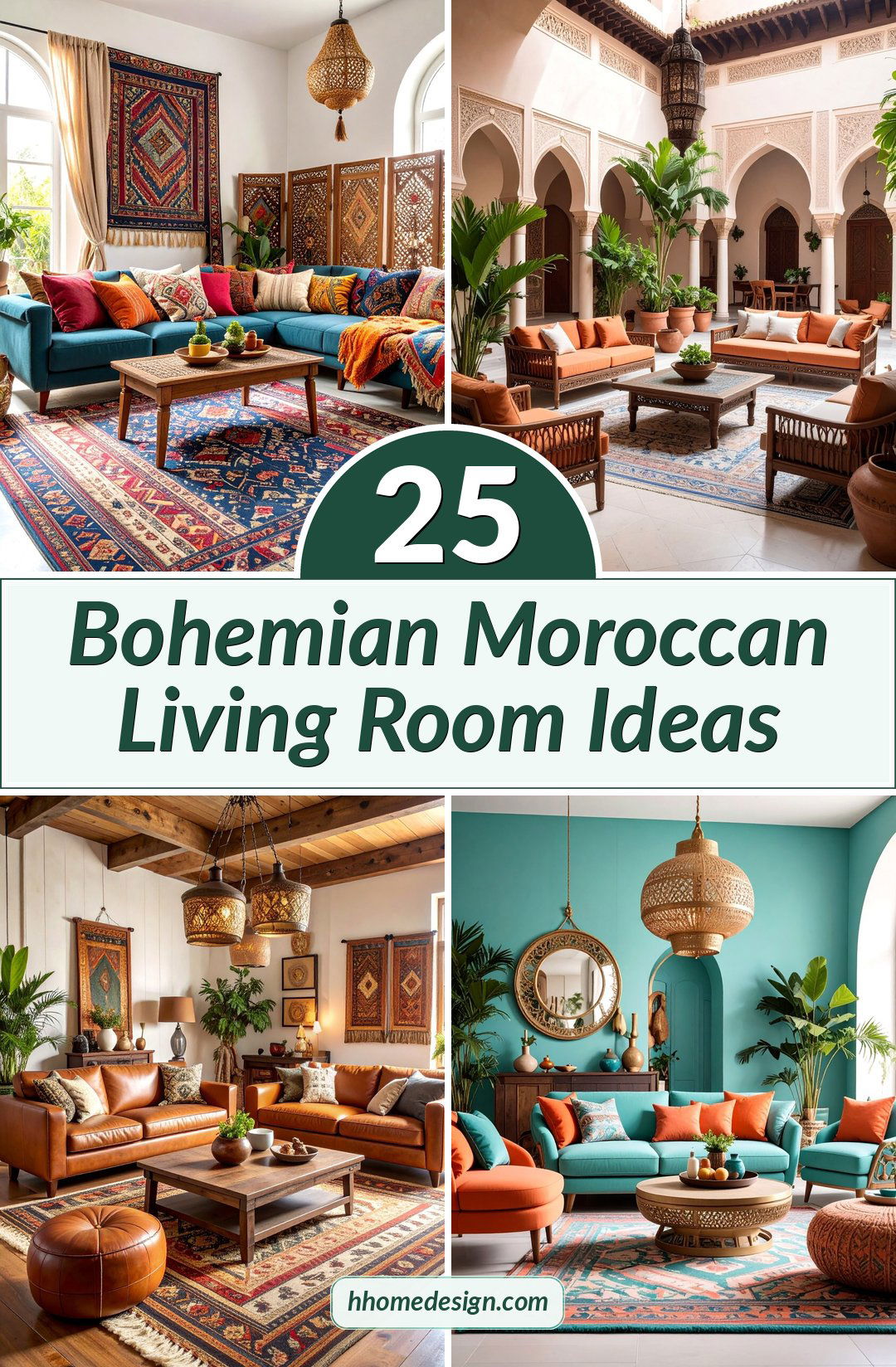
1. Jewel-Toned Maximalist Living Room
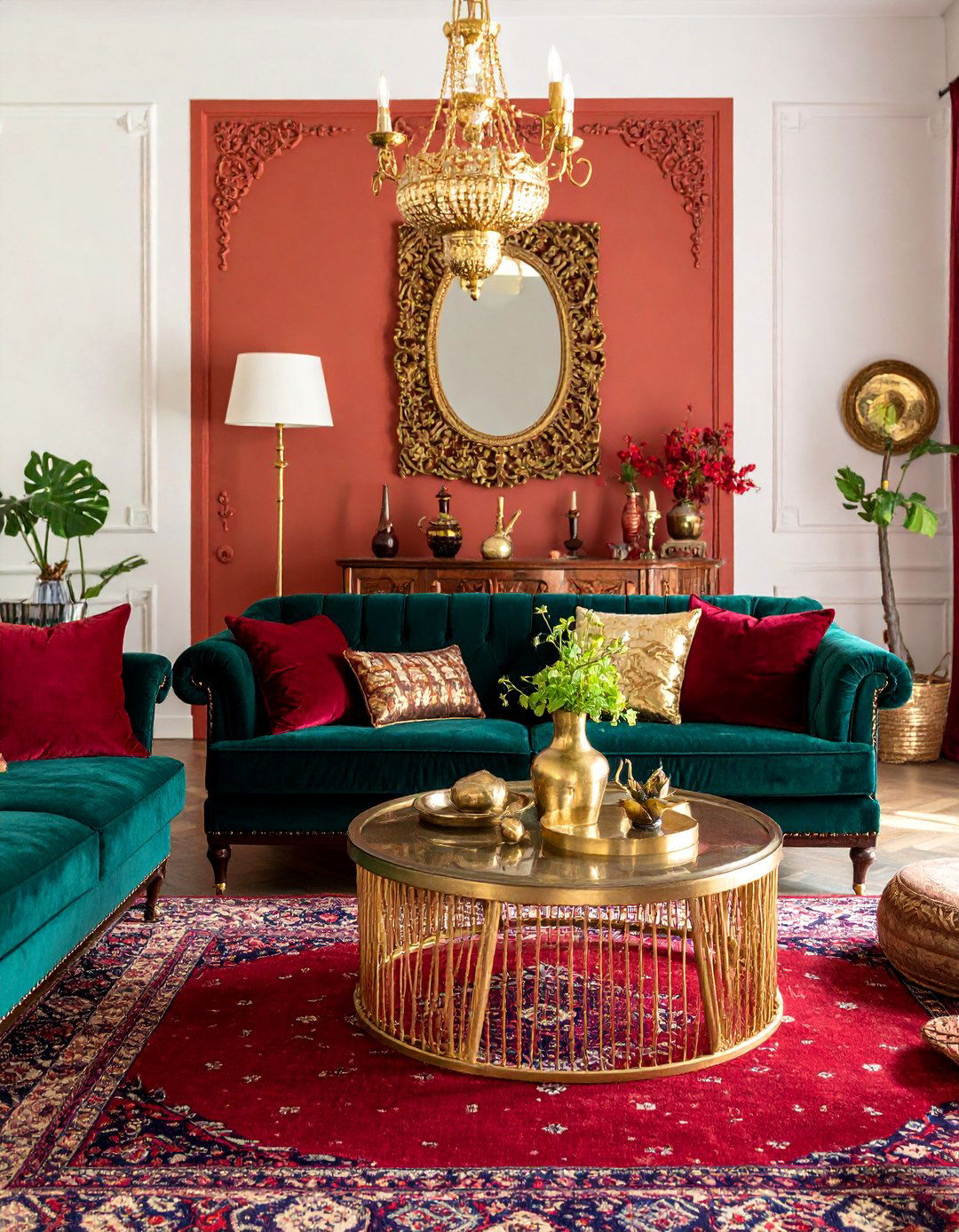
Create a luxurious living room centered around rich jewel tones and opulent textures. Layer deep emerald velvet sofas with copper and gold Moroccan poufs, while ornate brass lanterns cast warm patterns across terra-cotta walls. Multiple vintage Boujad rugs in vibrant reds and purples overlap on dark hardwood floors, creating visual depth. Intricate geometric throw pillows in sapphire and amber complement low carved wooden coffee tables displaying handmade ceramics. Flowing curtains in sunset orange frame windows, while potted palms add natural elements. This maximalist approach celebrates abundance through carefully curated textiles, metallic accents, and cultural artifacts that create an immersive, palace-like atmosphere perfect for entertaining.
2. Desert Sunset Living Room with Warm Earth Tones
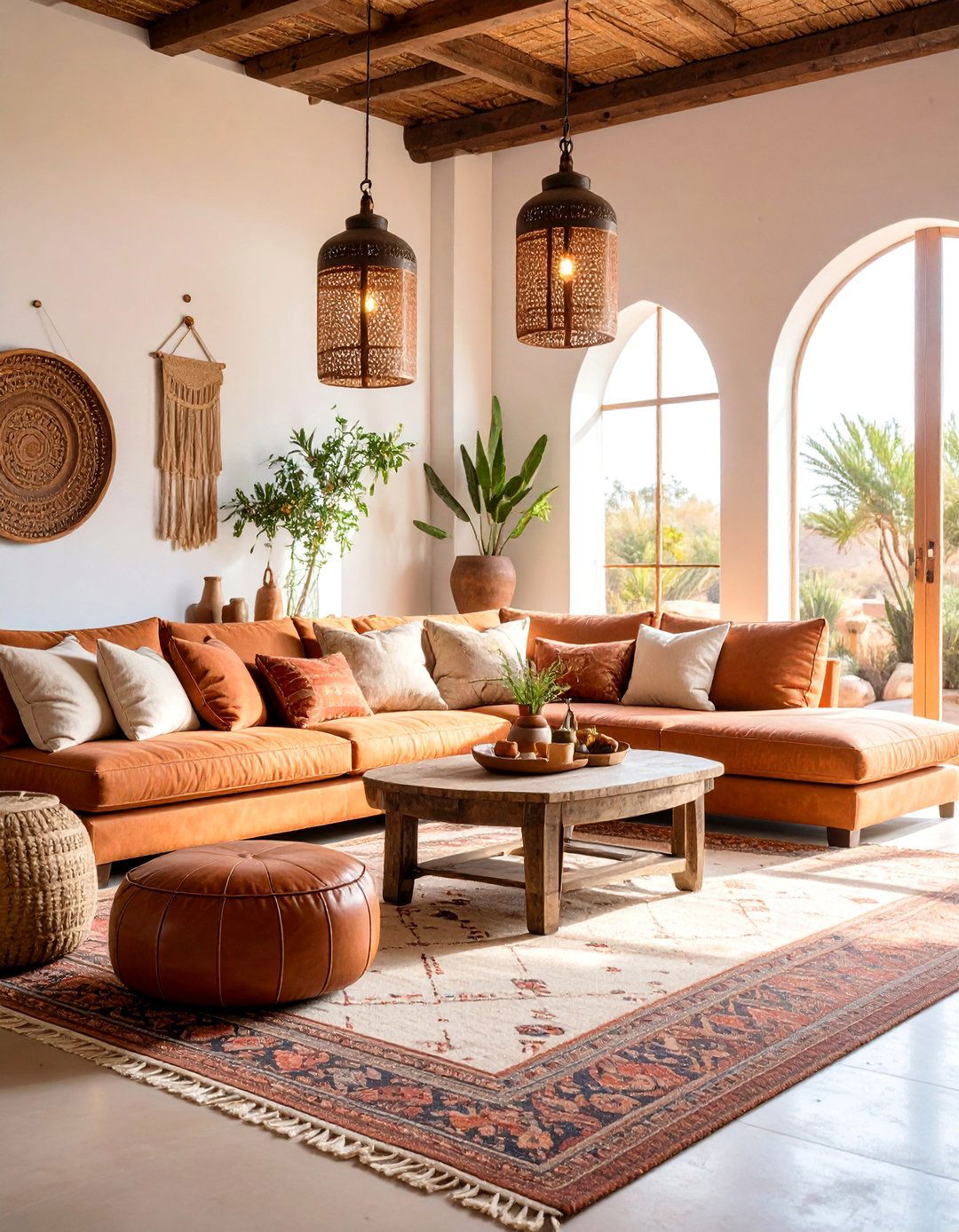
Transform your space into a desert oasis using warm earth tones inspired by Moroccan sunsets. Plush terracotta sectional seating surrounds a low brass-topped coffee table, while sandy beige walls provide a neutral backdrop. Large Beni Ourain rugs in cream and brown anchor the seating area, complemented by camel-colored leather poufs. Woven baskets serve as both storage and decoration, while dried pampas grass and cacti add desert textures. Pendant lanterns in oxidized copper create ambient lighting, casting dancing shadows reminiscent of desert evenings. Natural linen curtains filter light softly, while handwoven throws in burnt orange and rust complete this warm, earthy sanctuary.
3. Indigo and White Coastal Moroccan Living Room
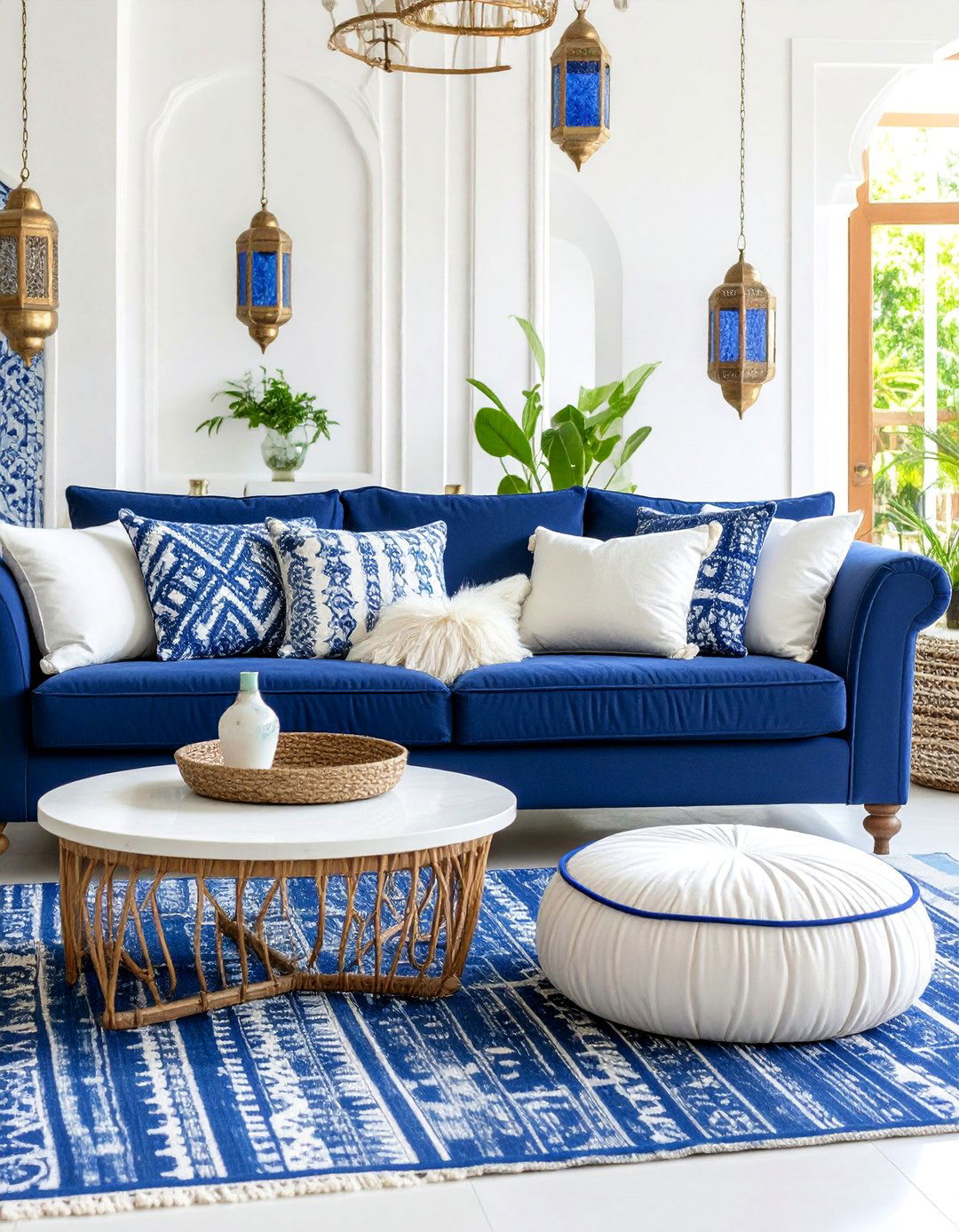
Combine coastal freshness with Moroccan sophistication through an indigo and white color palette. White-washed walls showcase intricate blue geometric tiles as accent features, while a navy blue low-profile sofa anchors the space. Layered blue and white Kilim rugs create pattern without overwhelming, complemented by white ceramic poufs with blue trim. Flowing white cotton curtains frame ocean-view windows, while brass lanterns with blue glass panels provide accent lighting. Natural jute elements and white-painted wooden furniture maintain the coastal feel. Potted olive trees and succulents add greenery, while handmade blue ceramics displayed on floating shelves complete this serene, Mediterranean-inspired Moroccan living room.
4. Vintage Eclectic Bohemian Living Room

Design an eclectic living room that celebrates vintage Moroccan craftsmanship and global collecting. Mix antique leather Chesterfield sofas with vintage Azilal rugs featuring bold geometric patterns in multiple colors. Collected treasures from various cultures create visual interest: Moroccan brass trays, Turkish ceramics, and Indian textiles. Multiple pendant lights in different metals and styles hang at varying heights, creating a collected-over-time aesthetic. Weathered wooden furniture pieces with intricate carvings serve as coffee and side tables. Layered vintage textiles including embroidered pillows, woven throws, and tapestries create rich texture. This curated approach tells stories through objects while maintaining cohesive warmth and cultural richness.
5. Modern Minimalist Moroccan Living Room
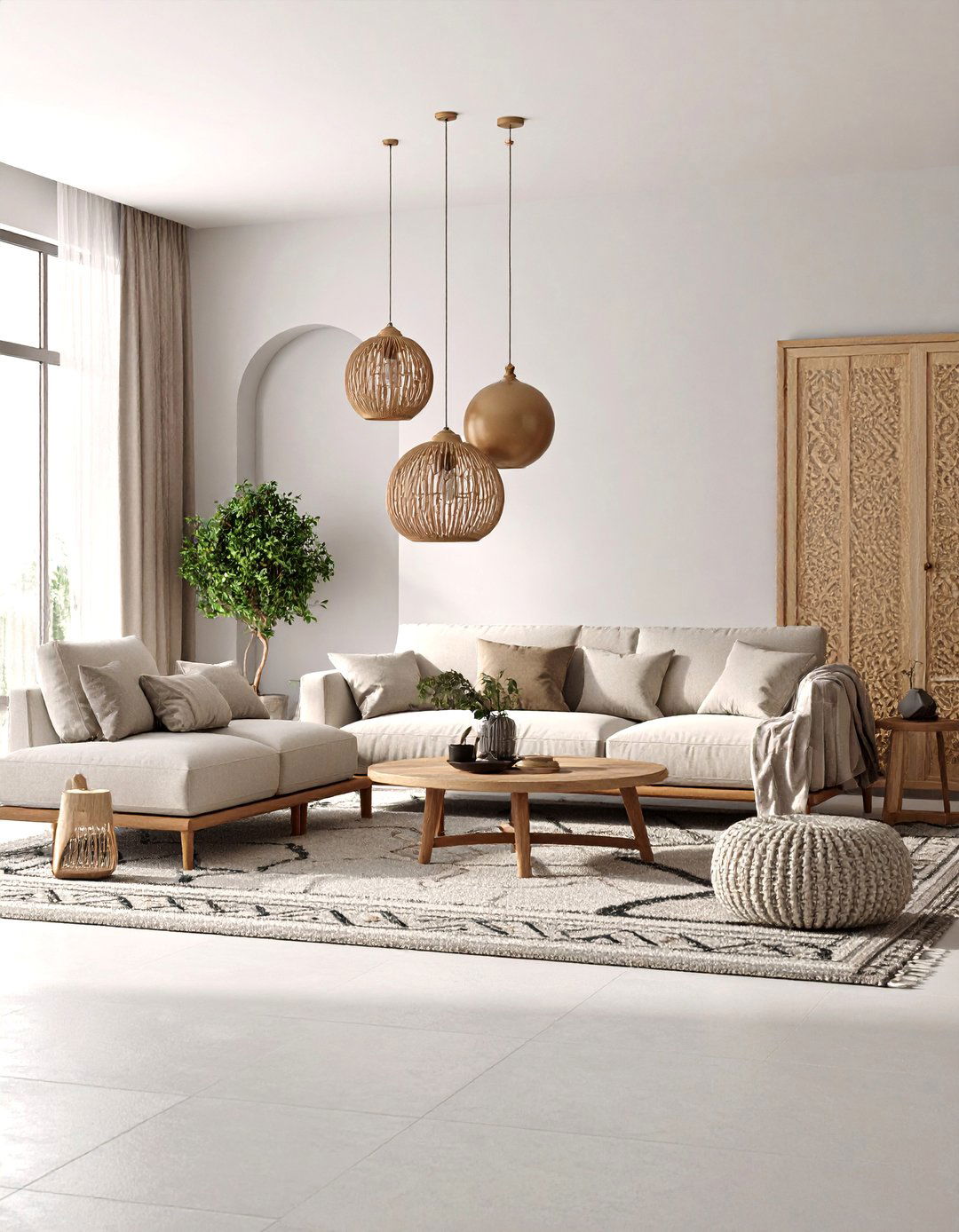
Create a contemporary interpretation of Moroccan design using clean lines and strategic cultural elements. Neutral-toned modular seating in cream and beige provides modern comfort, while a single statement Beni Ourain rug defines the space. Geometric wall panels in soft gray add subtle Moroccan pattern without overwhelming. Streamlined brass pendant lights provide ambient illumination, while a few carefully chosen Moroccan accessories serve as focal points. Natural materials like light wood and linen maintain simplicity, while potted fiddle leaf figs add organic elements. This approach proves that Moroccan influence can enhance modern spaces without sacrificing clean aesthetics or contemporary functionality.
6. Textile-Rich Pattern Paradise Living Room

Embrace the Moroccan tradition of layered textiles by creating a living room that celebrates pattern and texture. Multiple rugs in complementary patterns layer across the floor, while upholstered furniture features different but coordinating fabrics. Moroccan geometric prints mix with ikat patterns and tribal motifs on pillows, throws, and wall hangings. Rich fabrics like velvet, silk, and wool create tactile interest throughout the space. Carved wooden screens and room dividers add architectural pattern elements, while textile wall hangings serve as artwork. Warm brass lighting highlights the rich textures, while plants in woven baskets add natural balance. This approach creates visual richness while maintaining harmony through careful color coordination.
7. Brass and Metallic Accent Living Room
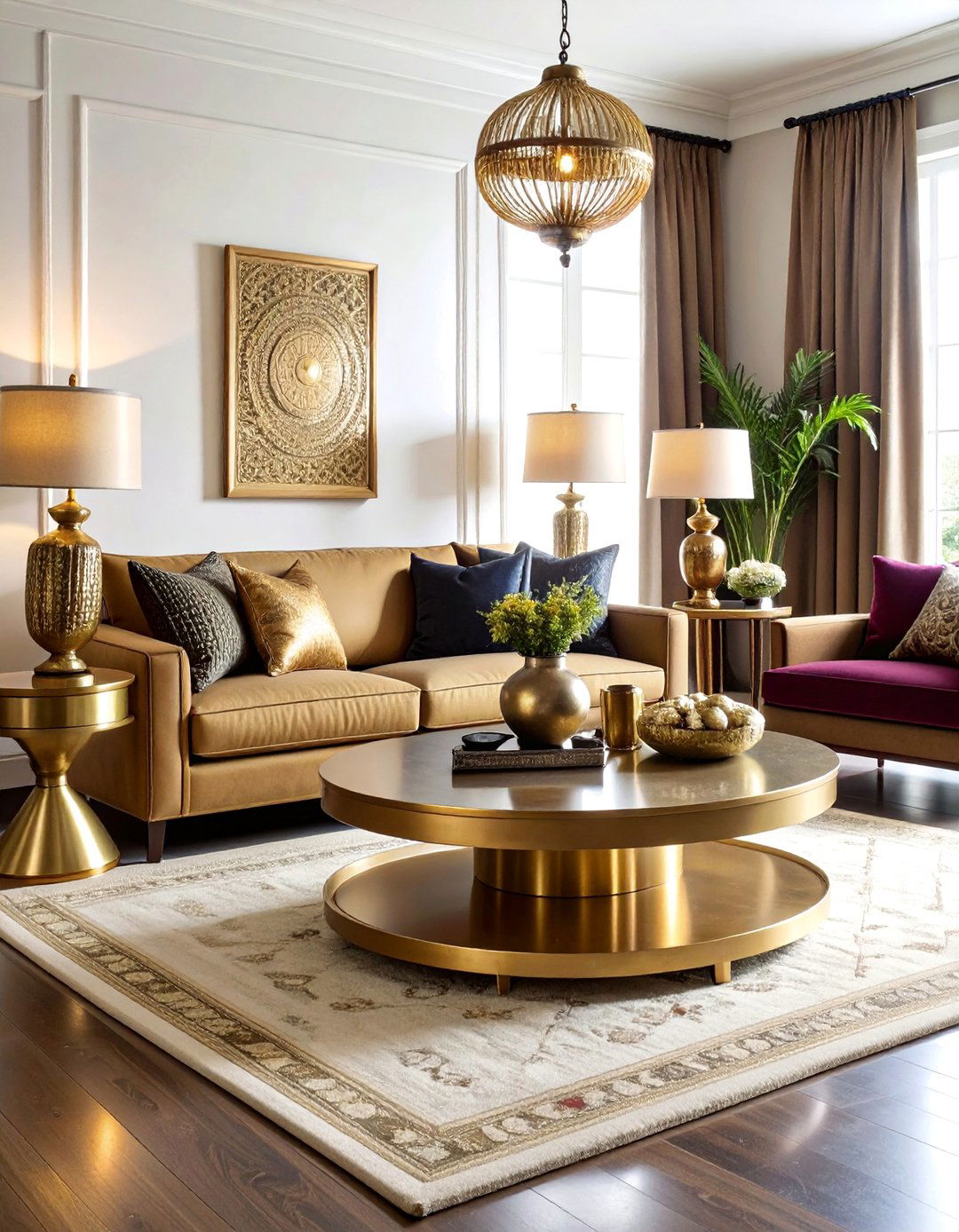
Design a sophisticated living room that highlights the metallic craftsmanship of Moroccan artisans. Brass coffee tables, side tables, and decorative objects create golden warmth against neutral upholstery and walls. Multiple brass lanterns of varying sizes provide ambient lighting, while copper accents add depth and variation. Metallic-threaded pillows and throws catch light beautifully, creating shimmer throughout the space. Rich burgundy and deep purple textiles provide contrast against the warm metals, while cream-colored walls allow metallic elements to take center stage. Handcrafted metal artwork and mirrors with ornate frames complete the sophisticated metallic theme. This approach creates luxury through the celebration of traditional Moroccan metalwork and modern comfort.
8. Low Floor Seating Moroccan Living Room
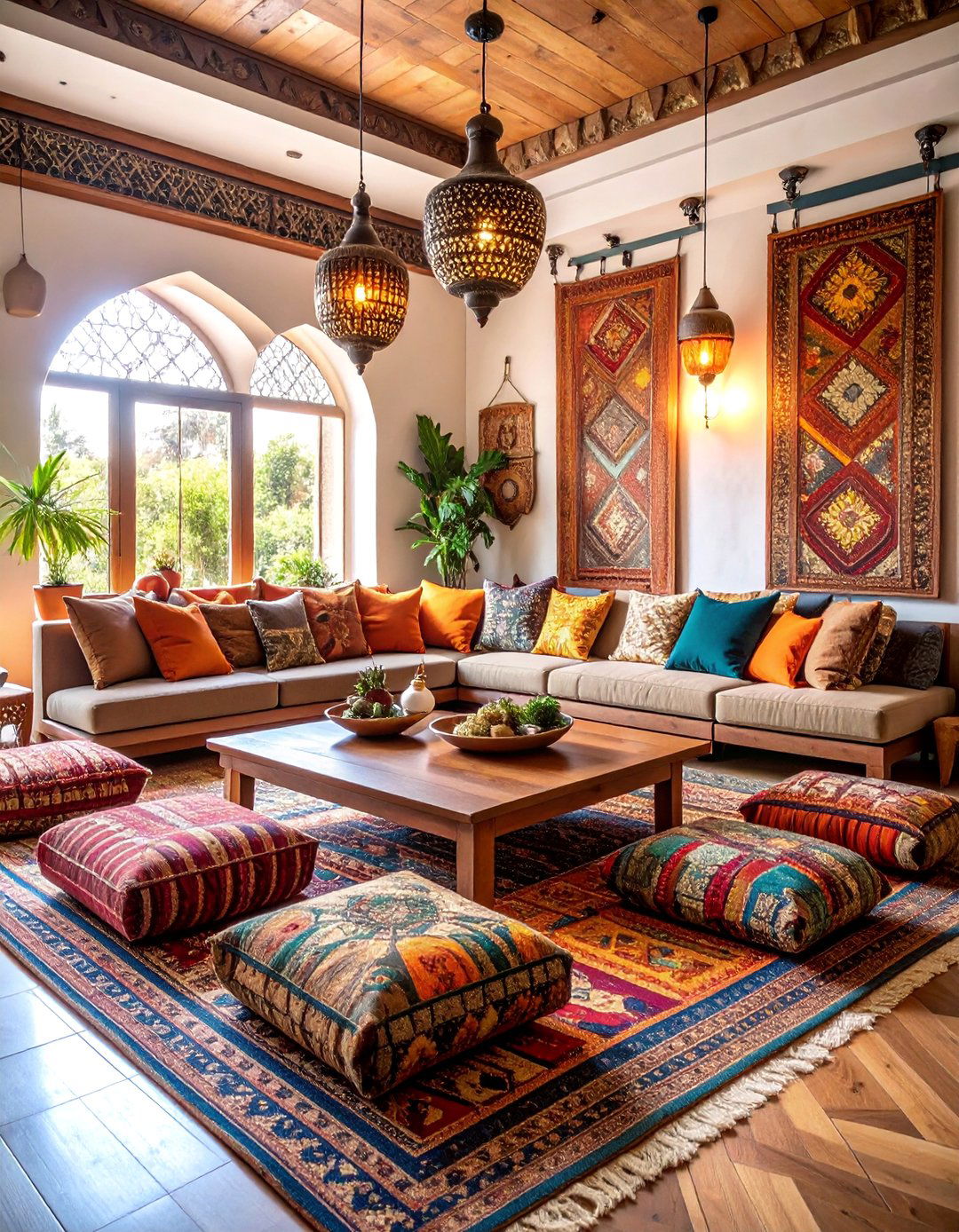
Create an intimate, traditional-inspired living room focused on floor seating and low furniture. Large Moroccan floor cushions in rich fabrics surround low wooden coffee tables, encouraging relaxed gathering and conversation. Layered rugs create soft seating areas, while wall-mounted cushions provide back support. Low brass tables display tea service and decorative objects, maintaining authentic cultural elements. Pendant lights hang lower to accommodate the reduced sight lines, while floor lanterns provide additional ambient lighting. Tapestries and fabric wall hangings add softness and color, while plants in low pots maintain the horizontal emphasis. This arrangement promotes intimacy and cultural authenticity while providing comfortable modern functionality.
9. Plant-Filled Moroccan Oasis Living Room

Transform your living room into a lush oasis by combining Moroccan design with abundant greenery. Large palms and fiddle leaf figs create natural architecture, while trailing plants in hanging brass planters add vertical interest. Moroccan ceramic pots in earth tones house various succulents and flowering plants, creating natural color accents. Natural fiber rugs and jute furniture complement the organic theme, while wooden elements add warmth. Brass lanterns and copper accessories reflect light beautifully among the greenery. Flowing curtains in natural linen maintain the organic feel, while plant-inspired Moroccan tiles create accent walls. This approach creates a living, breathing space that celebrates both cultural heritage and natural beauty.
10. Moroccan Tapestry and Wall Art Living Room
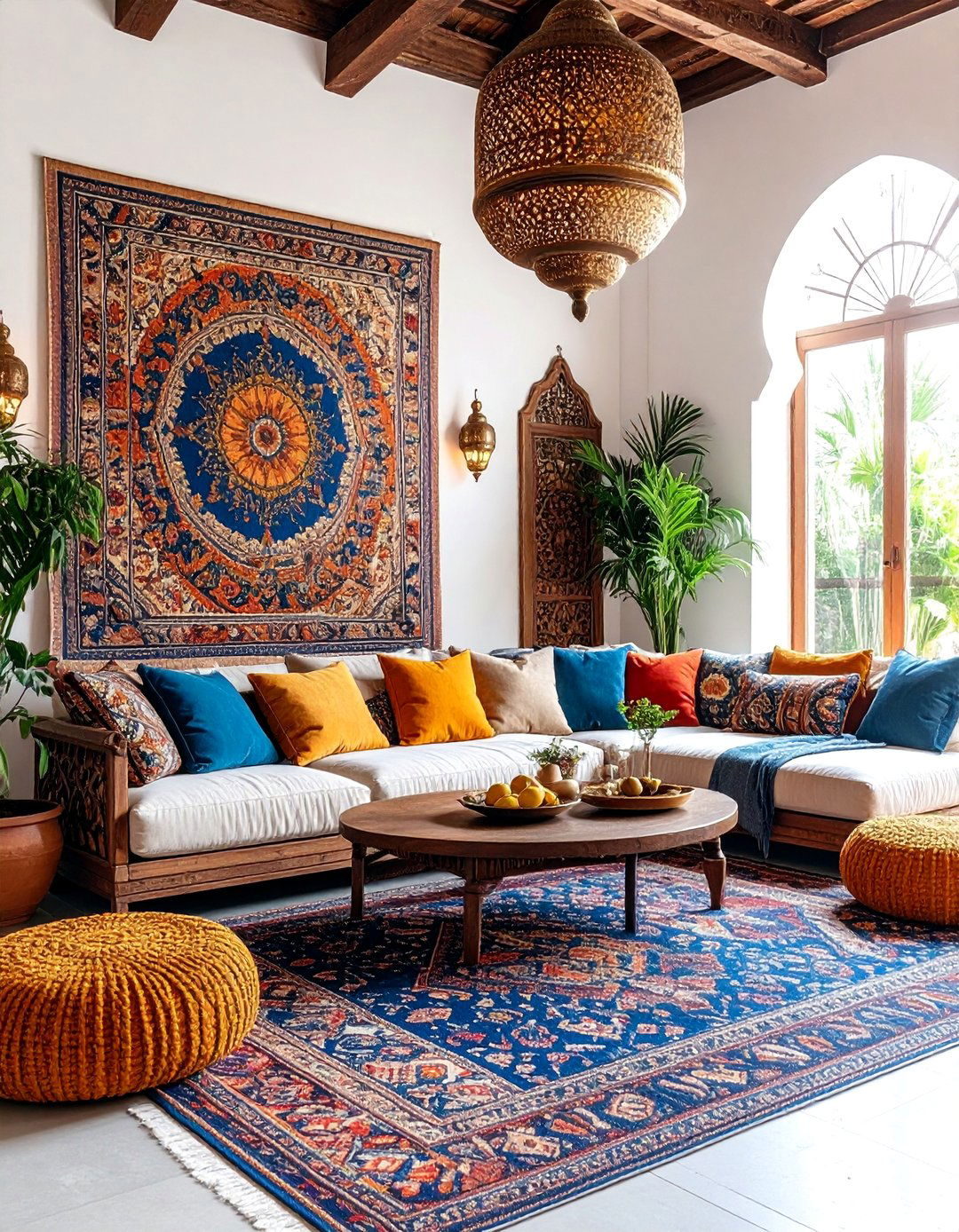
Design a living room that celebrates Moroccan artistic traditions through textile wall art and handcrafted objects. Large vintage Moroccan tapestries serve as dramatic wall focal points, displaying intricate geometric patterns and rich colors. Handwoven wall hangings in various sizes create gallery-like displays, while carved wooden panels add architectural interest. Furniture remains relatively simple to allow artwork to take precedence, featuring neutral upholstery and natural wood. Brass picture lights and wall sconces highlight the textile collections, while floor lamps provide general illumination. Colorful throw pillows echo the wall art patterns, creating cohesion throughout the space. This approach treats the living room as an art gallery celebrating Moroccan cultural heritage.
11. Amber and Terracotta Warmth Living Room

Create a cozy living room using the warm amber and terracotta tones of Moroccan pottery and desert landscapes. Rich terracotta walls provide a dramatic backdrop for cream and amber-toned furniture, while brass accessories add metallic warmth. Handmade ceramic vessels in various earth tones serve as decorative focal points, while woven textiles in coordinating warm colors add softness. Natural wood furniture with warm finishes complements the earth-tone palette, while amber glass lanterns create golden ambient lighting. Layered rugs in burnt orange and cream define seating areas, while potted plants in terracotta containers maintain the earthy theme. This monochromatic approach creates enveloping warmth and sophisticated color harmony.
12. Moroccan Lantern Lighting Feature Living Room
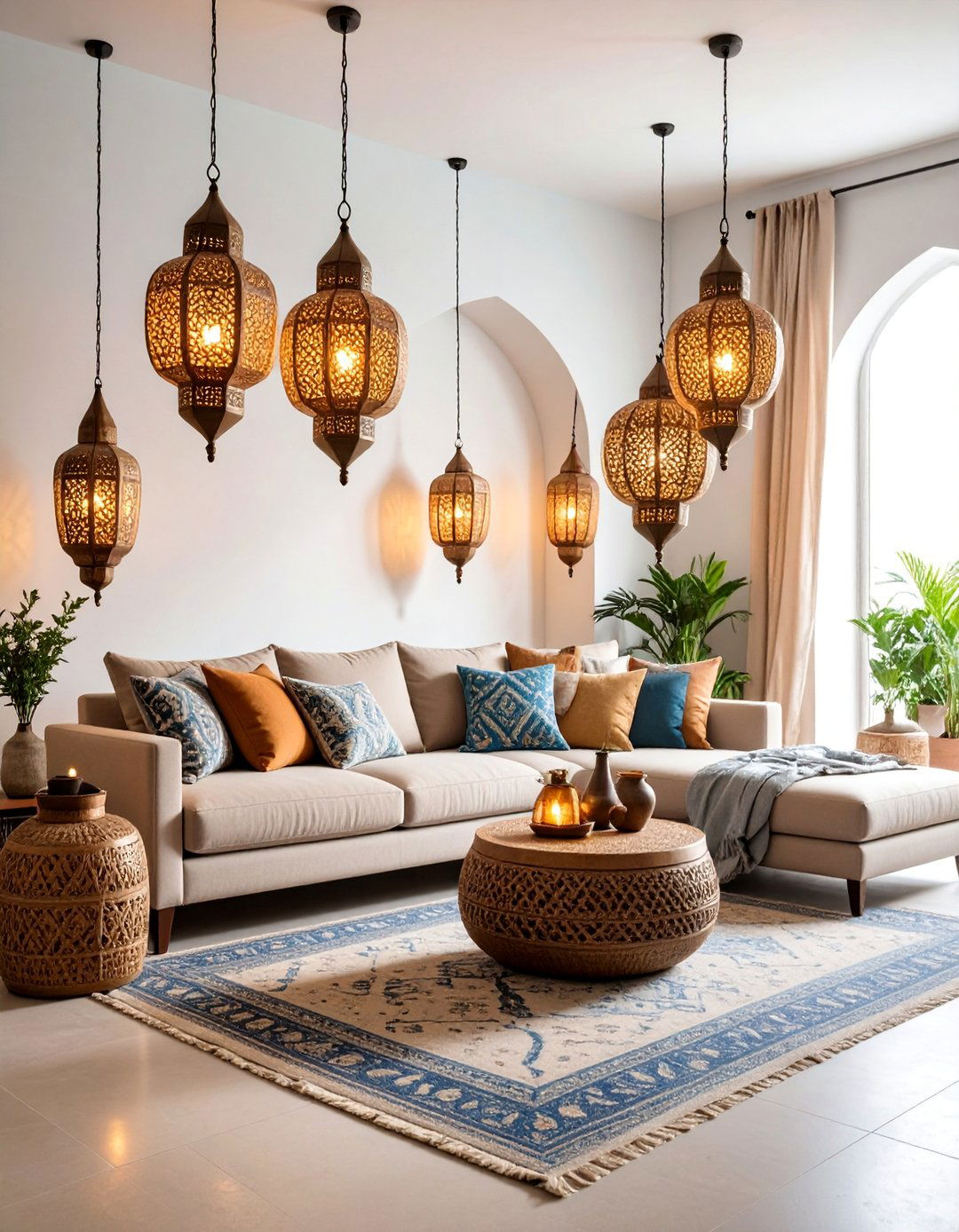
Design a living room that showcases the dramatic lighting effects of traditional Moroccan lanterns. Multiple pendant lanterns of varying sizes hang at different heights, creating layers of ambient lighting throughout the space. Table and floor lanterns provide additional illumination while maintaining the metallic theme. Neutral furniture allows the lighting to take center stage, while patterned shadows cast by the lanterns become decorative elements themselves. Brass and copper finishes dominate the metallic palette, while warm earth tones in textiles complement the golden lighting. Mirror accents reflect and amplify the lantern effects, while sheer curtains allow natural light to filter gently. This approach creates drama through lighting while maintaining comfortable functionality.
13. Vintage Kilim and Leather Living Room
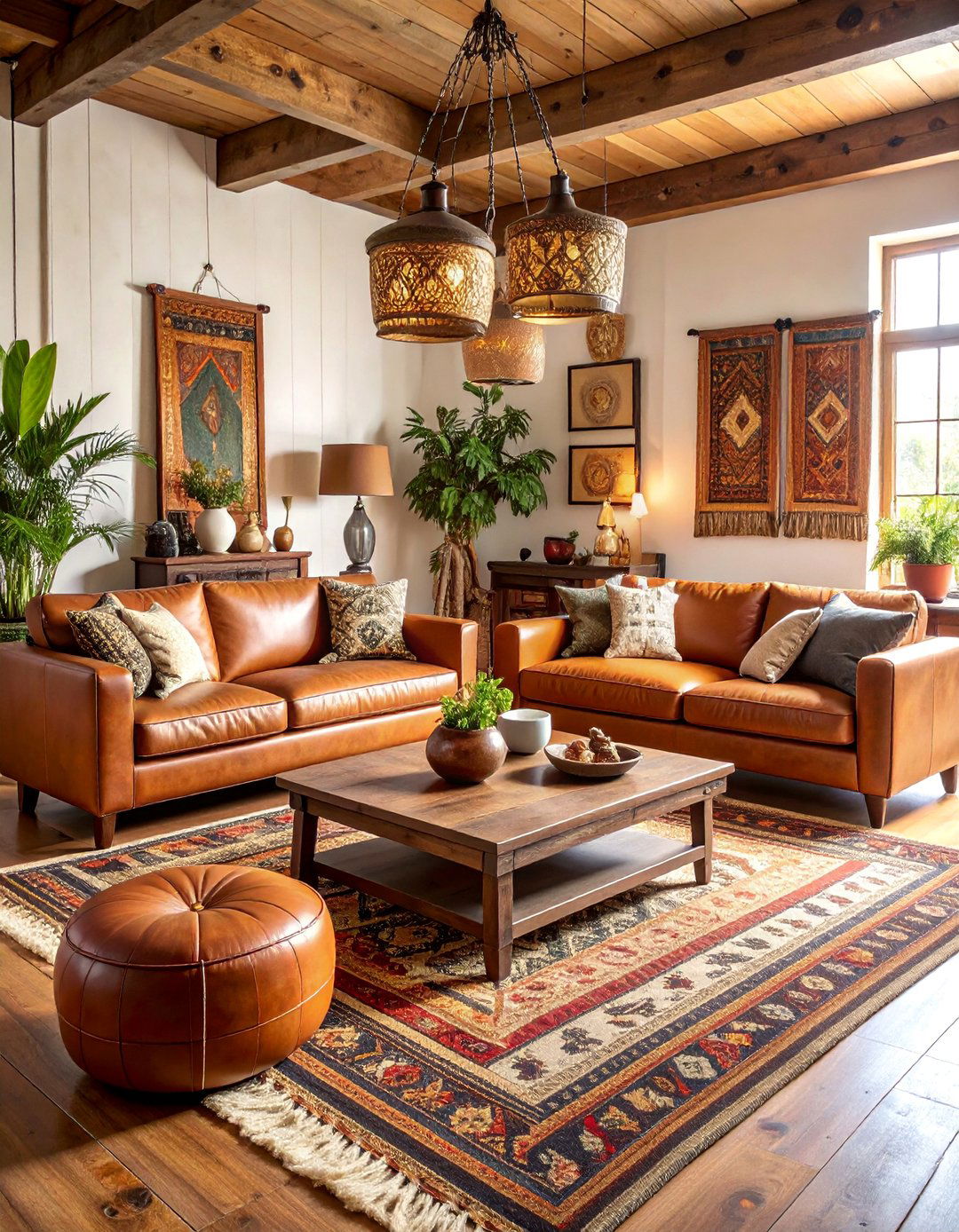
Combine the rustic charm of vintage Kilim rugs with rich leather furniture for a sophisticated Moroccan living room. Worn leather sofas in cognac and brown create comfortable seating, while layered vintage Kilim rugs add pattern and color to hardwood floors. Distressed wooden coffee tables display brass accessories and ceramic objects, while leather ottomans provide additional seating and storage. Warm earth tones dominate the palette, with pops of traditional Kilim colors adding visual interest. Vintage brass lanterns and leather-wrapped furniture legs maintain the material theme throughout. Natural textures like jute and sisal complement the leather and wool elements, while plants in woven baskets add organic balance to this richly textured space.
14. Turquoise and Coral Moroccan Living Room

Create a vibrant living room using the stunning color combination of turquoise and coral inspired by Moroccan ceramics and textiles. Turquoise-painted accent walls provide a bold backdrop for coral-colored seating, while brass accessories add metallic warmth between the cool and warm tones. Patterned rugs incorporate both colors with traditional geometric designs, while ceramic accessories in various shades of blue and orange create collecting displays. Natural materials like rattan and wood provide neutral balance, while white architectural elements keep the bold colors from overwhelming. Pendant lights with colored glass panels cast tinted light, while plants in turquoise ceramic pots complete the vibrant yet sophisticated color story.
15. Moroccan Geometric Pattern Living Room
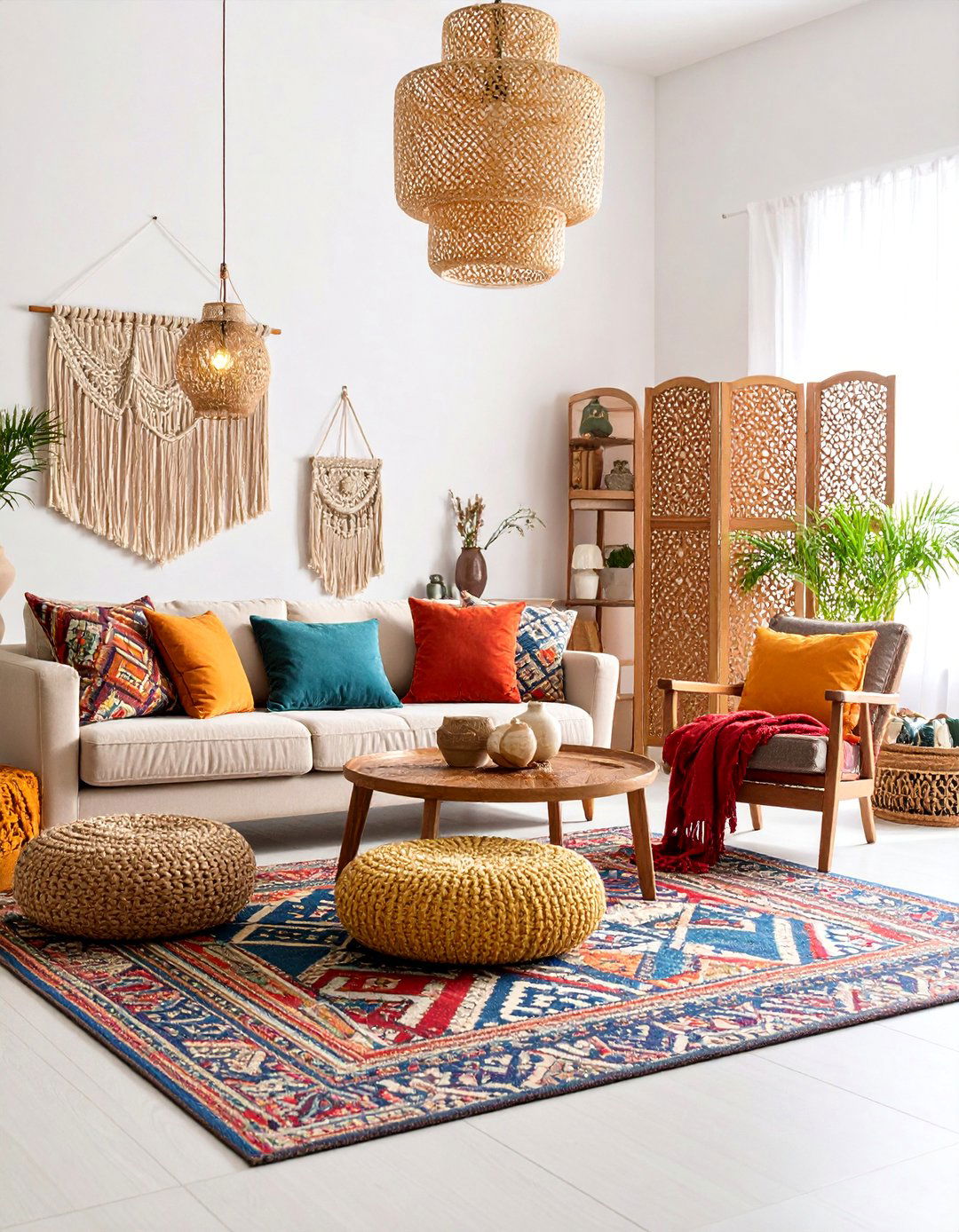
Design a living room that celebrates the mathematical beauty of Moroccan geometric patterns through various design elements. Geometric-patterned wallpaper or wall stencils create dramatic accent walls, while furniture upholstery features coordinating but varied geometric prints. Layered rugs with different geometric patterns create visual complexity while maintaining pattern harmony through color coordination. Carved wooden screens with geometric cutouts serve as room dividers and decorative elements, while brass accessories feature traditional star and polygon motifs. Lighting fixtures echo geometric themes through metalwork patterns, while throw pillows display various scales of geometric design. This approach creates sophisticated pattern play while maintaining visual cohesion through careful scale and color management.
16. Moroccan Courtyard Indoor Living Room

Recreate the serene atmosphere of a Moroccan courtyard within your living room through architectural elements and water features. Arched doorways and niches create architectural interest, while a small tabletop fountain provides the soothing sound of water. Tiled surfaces in traditional Moroccan patterns accent walls and surfaces, while large plants in ceramic pots create garden-like ambiance. Low seating arrangements encourage relaxation, while natural materials like stone and wood complement the outdoor-inspired theme. Soft lighting from lanterns and candles creates evening ambiance, while flowing fabrics and cushions add comfort to the architectural elements. This approach brings the peaceful essence of Moroccan courtyards indoors.
17. Rich Burgundy and Gold Living Room
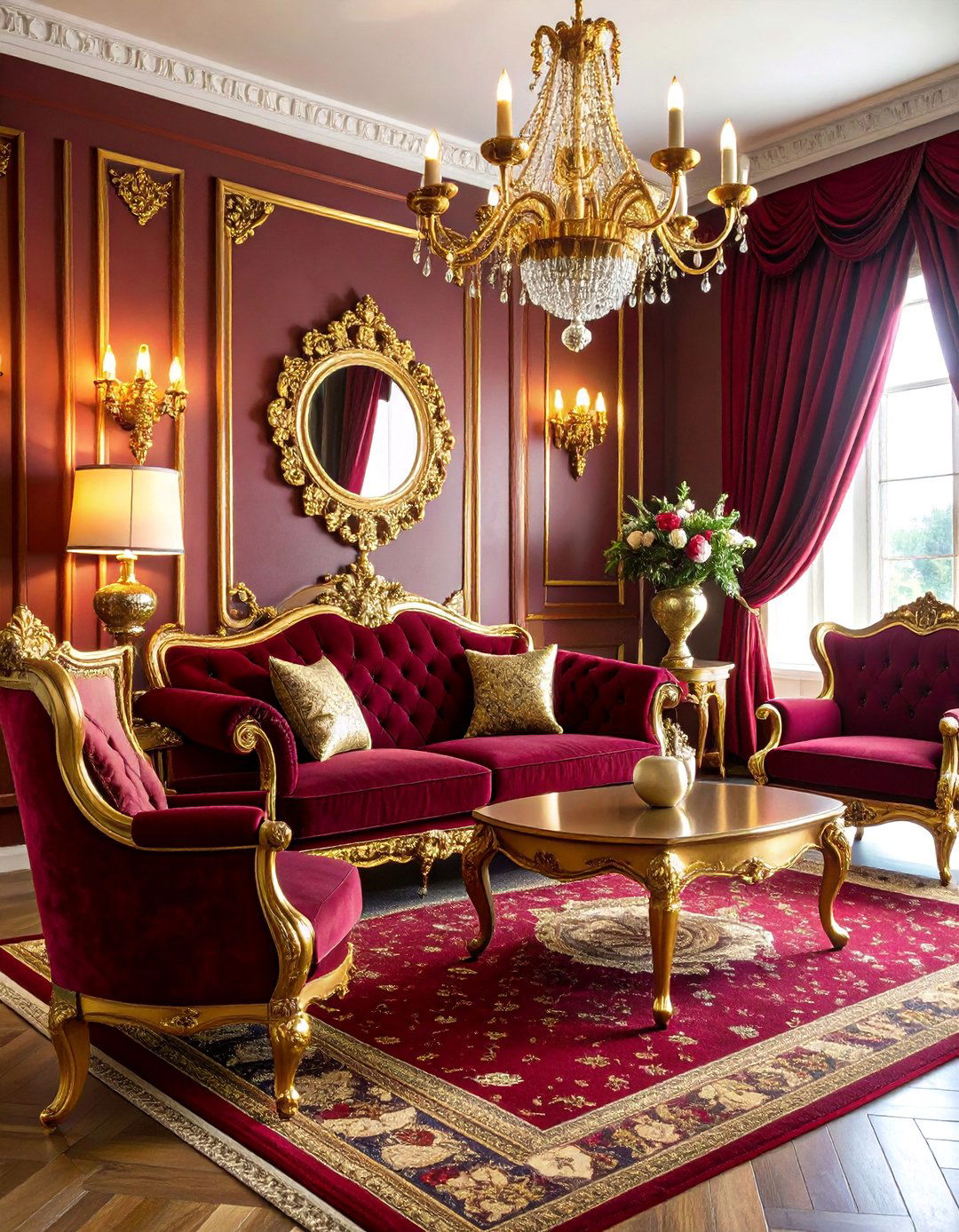
Create an opulent living room using the regal color combination of deep burgundy and gold inspired by Moroccan palaces. Rich burgundy velvet seating provides luxurious comfort, while gold-threaded textiles add metallic glamour throughout the space. Brass furniture and accessories create golden accents, while deep red Persian-style rugs anchor the seating areas. Heavy drapery in burgundy silk creates drama and intimacy, while gold-framed mirrors reflect light and create sparkle. Ornate brass chandeliers and table lamps provide warm illumination, while ceramic objects in coordinating colors serve as decorative accents. This sophisticated palette creates a sense of luxury and cultural richness while maintaining comfortable livability.
18. Natural Fiber and Texture Living Room

Design a living room that celebrates the natural materials and textures central to Moroccan craftsmanship. Jute and sisal rugs create textural foundation, while seating features natural linen and cotton upholstery. Woven baskets serve both decorative and functional purposes, while wooden furniture displays natural grain and texture. Hemp and cotton curtains filter light naturally, while plants in terracotta and ceramic vessels add living texture. Brass accessories provide metallic contrast against the organic materials, while leather accents add richness and depth. This approach emphasizes the handmade quality and natural beauty of traditional Moroccan materials while creating a serene, organic living environment.
19. Moroccan Sunset Ombre Living Room

Create a living room that captures the gradual color transitions of Moroccan sunsets through ombre color techniques. Walls transition from deep orange at the bottom to pale cream at the top, while textiles graduate through various sunset tones. Furniture arrangement follows the color flow, with deeper tones anchoring seating areas and lighter shades highlighting vertical elements. Graduated lighting creates the illusion of changing daylight, while metallic accents in copper and brass enhance the sunset theme. Natural elements like dried grasses and warm-toned stones complete the desert evening atmosphere. This technique creates visual movement and warmth while maintaining sophisticated color harmony throughout the space.
20. Moroccan Tile Feature Living Room

Design a living room that showcases the intricate beauty of traditional Moroccan tilework through strategic feature elements. A statement wall features authentic Moroccan tiles in traditional patterns, while smaller tile accents appear on coffee table tops and decorative objects. Coordinating colors in furniture and textiles complement the tile palette without competing, while neutral backgrounds allow the tilework to shine. Furniture with tiled inserts creates functional art pieces, while tile-topped side tables provide practical surfaces. Lighting highlights the tile details and creates interesting shadow patterns, while plants in tiled planters maintain the theme throughout. This approach celebrates Moroccan ceramic artistry while creating sophisticated focal points.
21. Moroccan Spice Market Living Room
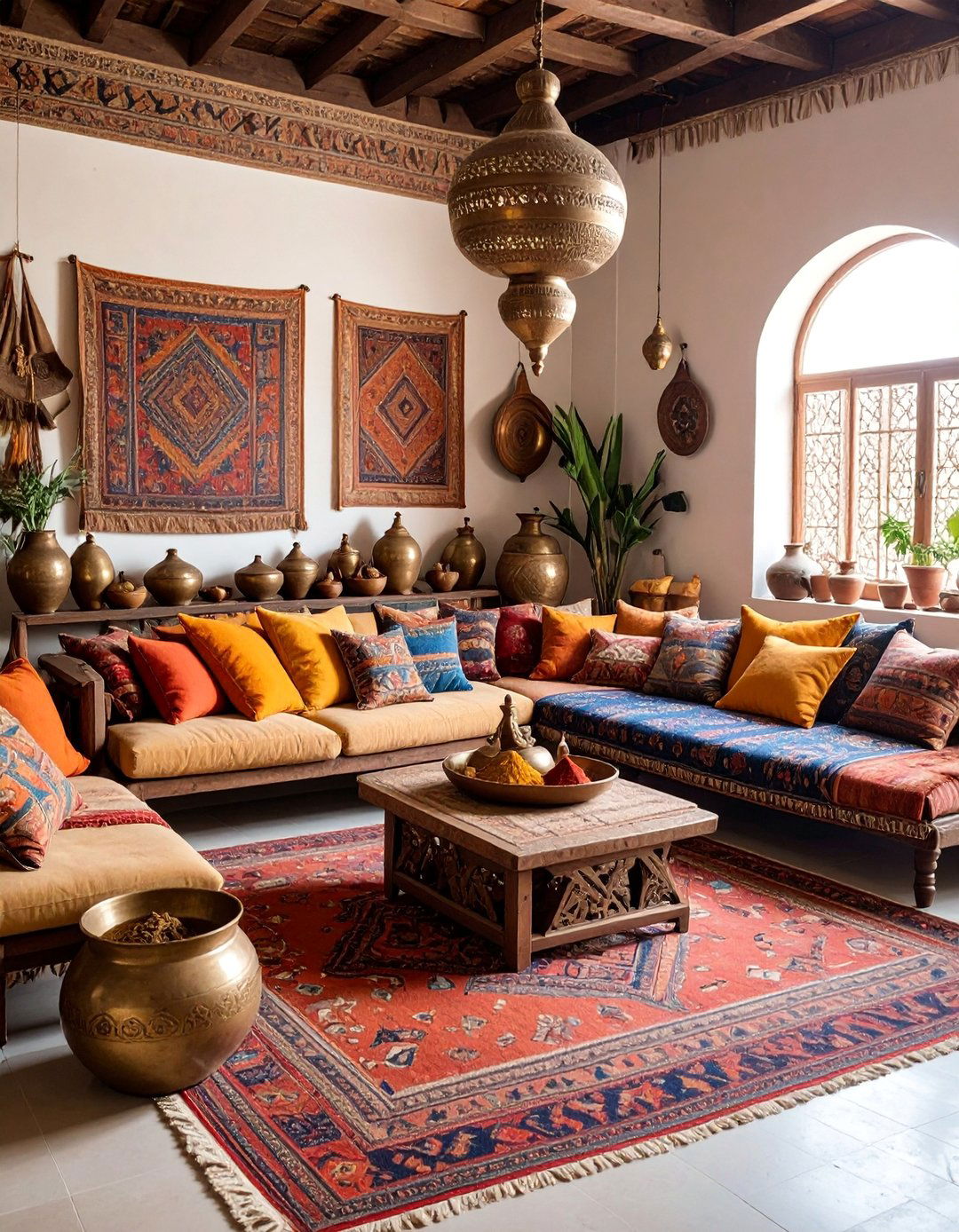
Create a living room inspired by the vibrant colors and textures of Moroccan spice markets. Warm spice colors including saffron yellow, paprika red, and cumin brown dominate the palette, while textiles feature rich, saturated tones. Layered rugs in market-inspired colors create warmth underfoot, while brass containers and vessels serve as decorative objects reminiscent of spice containers. Natural textures like burlap and rough-woven fabrics add authentic market feel, while wooden furniture displays natural grain and weathering. Pendant lights with punched metal shades cast pattern like market stall lighting, while ceramic bowls and plates display colorful fruits and decorative objects. This theme creates energetic warmth and cultural authenticity.
22. Moroccan Midnight Blue Living Room
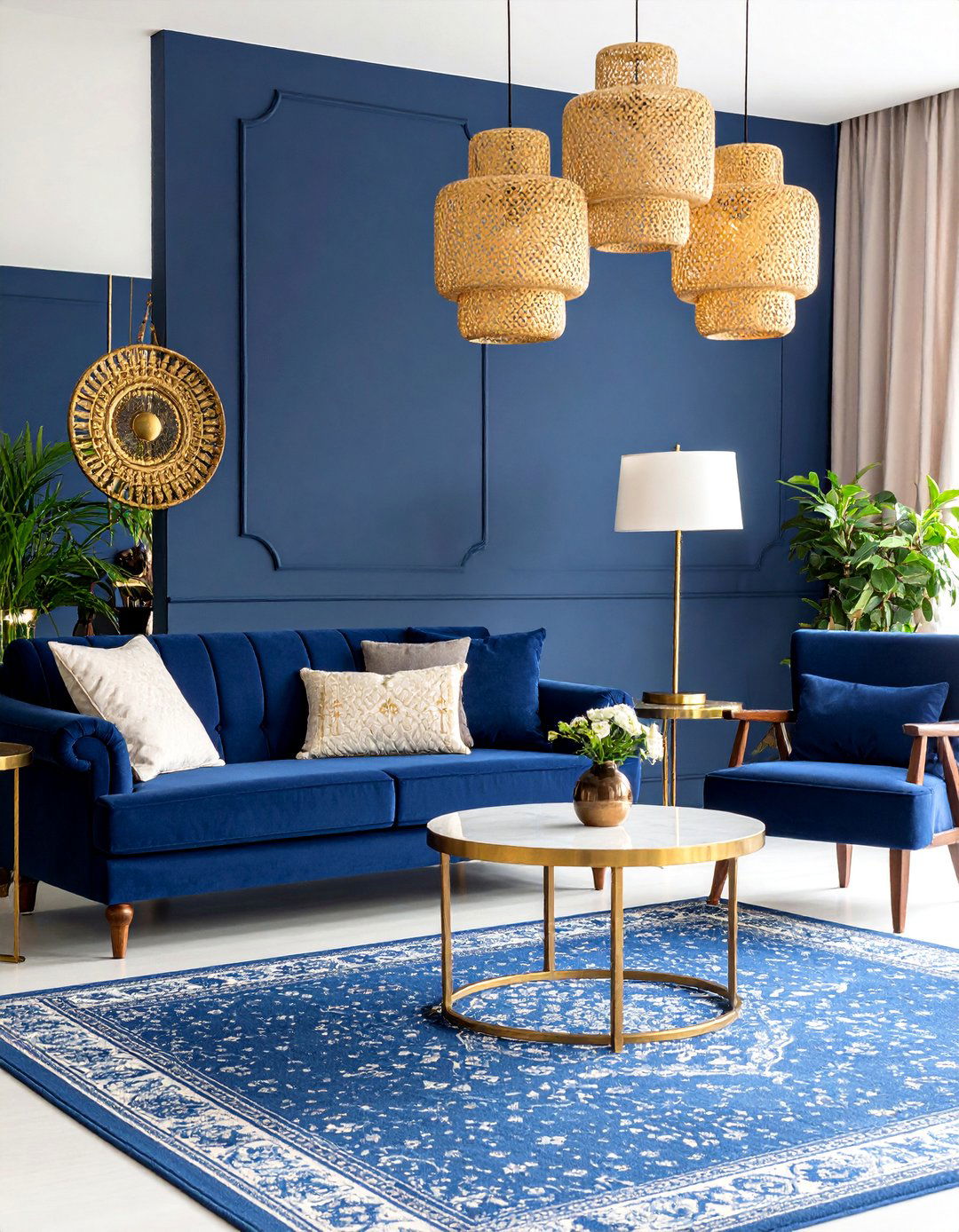
Design a sophisticated living room using deep midnight blue as the dominant color, inspired by Moroccan night skies. Rich navy blue walls create dramatic backdrop for brass and gold metallic accents, while cream and white elements provide contrast and balance. Blue-toned rugs anchor seating areas, while varied shades of blue in textiles create depth and interest. Brass lanterns and copper accessories warm the cool palette, while plants in blue ceramic containers maintain color harmony. Natural materials like light wood and cream leather prevent the dark colors from overwhelming, while strategic lighting creates warmth and intimacy. This monochromatic approach creates sophisticated drama while maintaining comfortable livability.
23. Moroccan Arch and Architecture Living Room

Create a living room that incorporates traditional Moroccan architectural elements through built-in features and furniture design. Arched doorways and windows add architectural authenticity, while built-in seating with cushions creates traditional majlis-style arrangement. Carved wooden screens serve as room dividers and decorative elements, while ornate plasterwork details add cultural authenticity. Furniture features architectural details like arched panels and carved supports, while lighting fixtures echo the arched theme. Geometric floor patterns using tile or painted designs reinforce the architectural focus, while textiles and accessories complement rather than compete with the structural elements. This approach creates immersive cultural atmosphere through authentic architectural details.
24. Moroccan Textile Layering Living Room

Design a living room that masters the Moroccan art of textile layering through strategic fabric placement. Multiple rugs layer across floors in complementary patterns and colors, while seating features different but coordinating fabrics. Throw pillows in various textures and patterns create rich surface interest, while blankets and throws add additional textile layers. Wall hangings and tapestries provide vertical textile interest, while curtains in flowing fabrics add softness and movement. Different weaves and textures from silk to wool to cotton create tactile variety, while careful color coordination maintains harmony despite pattern complexity. This approach celebrates Moroccan textile traditions while creating luxuriously comfortable and visually rich living spaces.
25. Moroccan Bohemian Reading Retreat Living Room
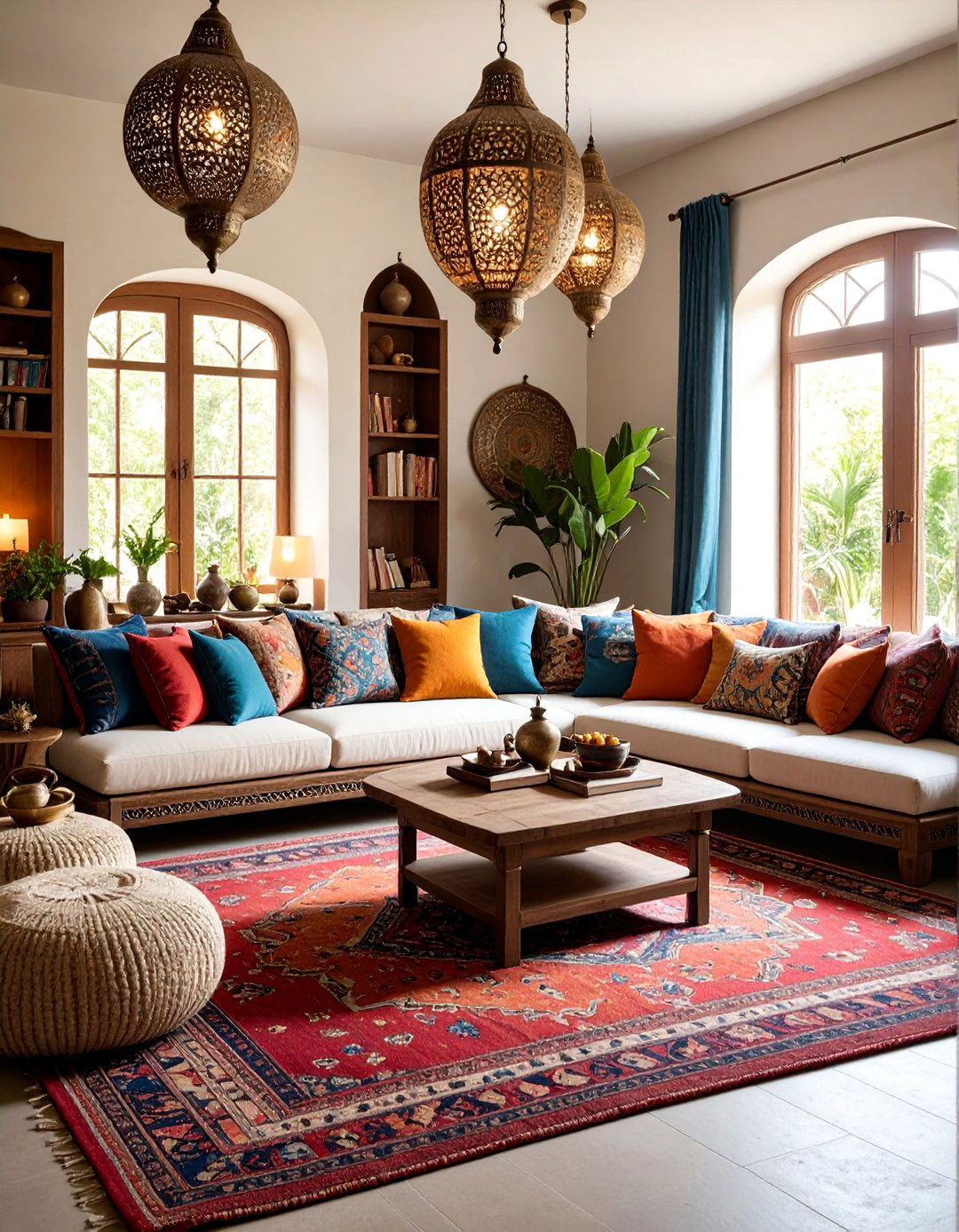
Create a cozy living room designed for relaxation and reading, incorporating comfortable Moroccan-inspired elements. Built-in reading nooks with abundant cushions provide intimate seating, while good lighting from brass table lamps and pendant lights supports reading activities. Soft textures dominate through plush rugs, comfortable seating, and layered textiles, while warm colors create relaxing ambiance. Low tables hold books, tea service, and reading accessories, while plants create natural tranquility. Sound-absorbing textiles and soft furnishings create peaceful atmosphere, while brass and wooden elements add cultural warmth. Storage solutions using beautiful baskets and carved boxes keep reading materials organized while maintaining decorative appeal. This space balances Moroccan cultural elements with modern comfort needs.
Conclusion:
Bohemian Moroccan living rooms offer endless possibilities for creating spaces that are both culturally rich and personally meaningful. By combining traditional Moroccan elements like intricate patterns, warm metals, and handcrafted textiles with bohemian principles of layering and global collecting, these designs create homes that tell stories and celebrate craftsmanship. Whether embracing maximalist jewel tones or minimalist earth tones, each approach honors the deep cultural heritage while meeting modern comfort needs, resulting in living spaces that are both beautiful and deeply welcoming.


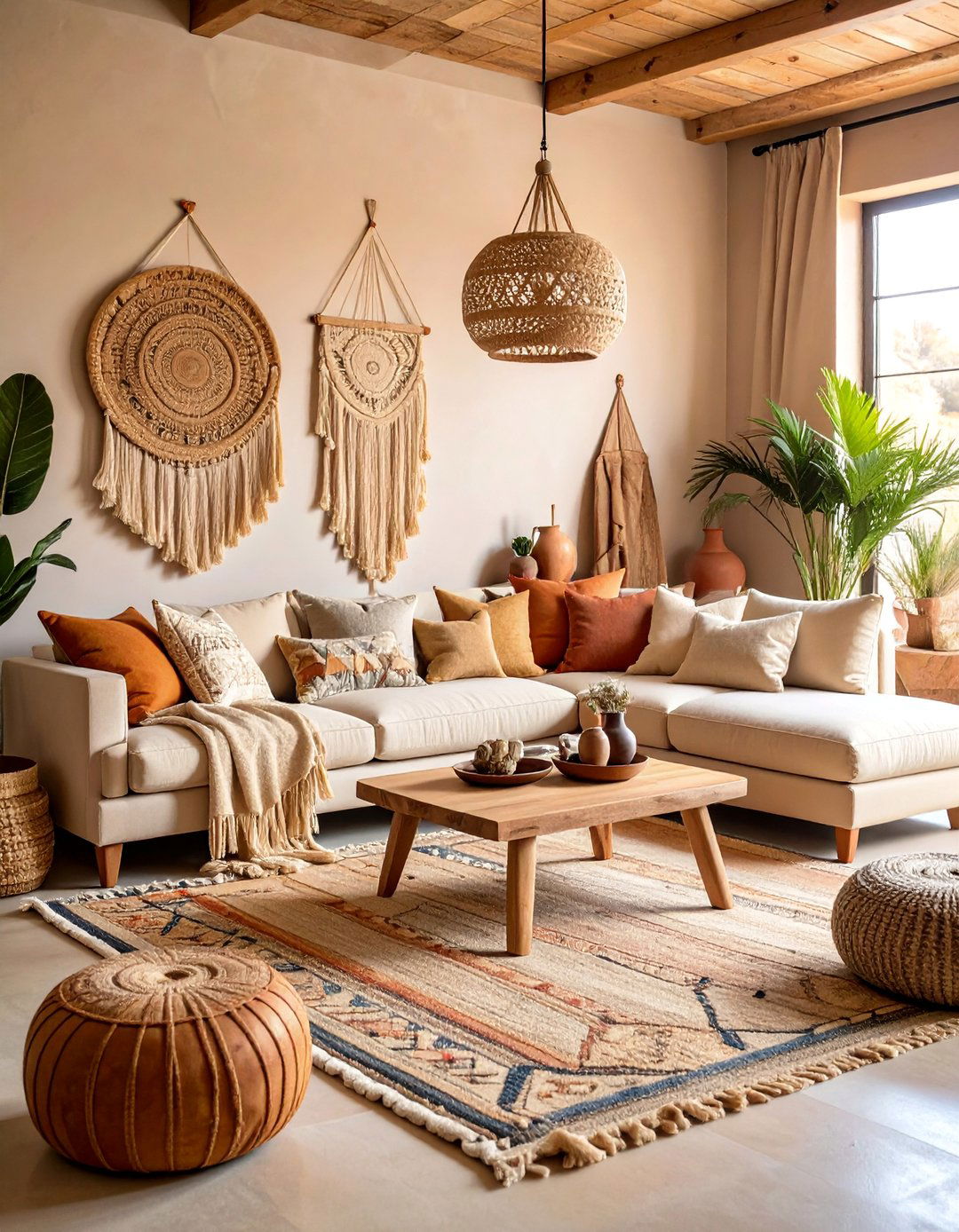

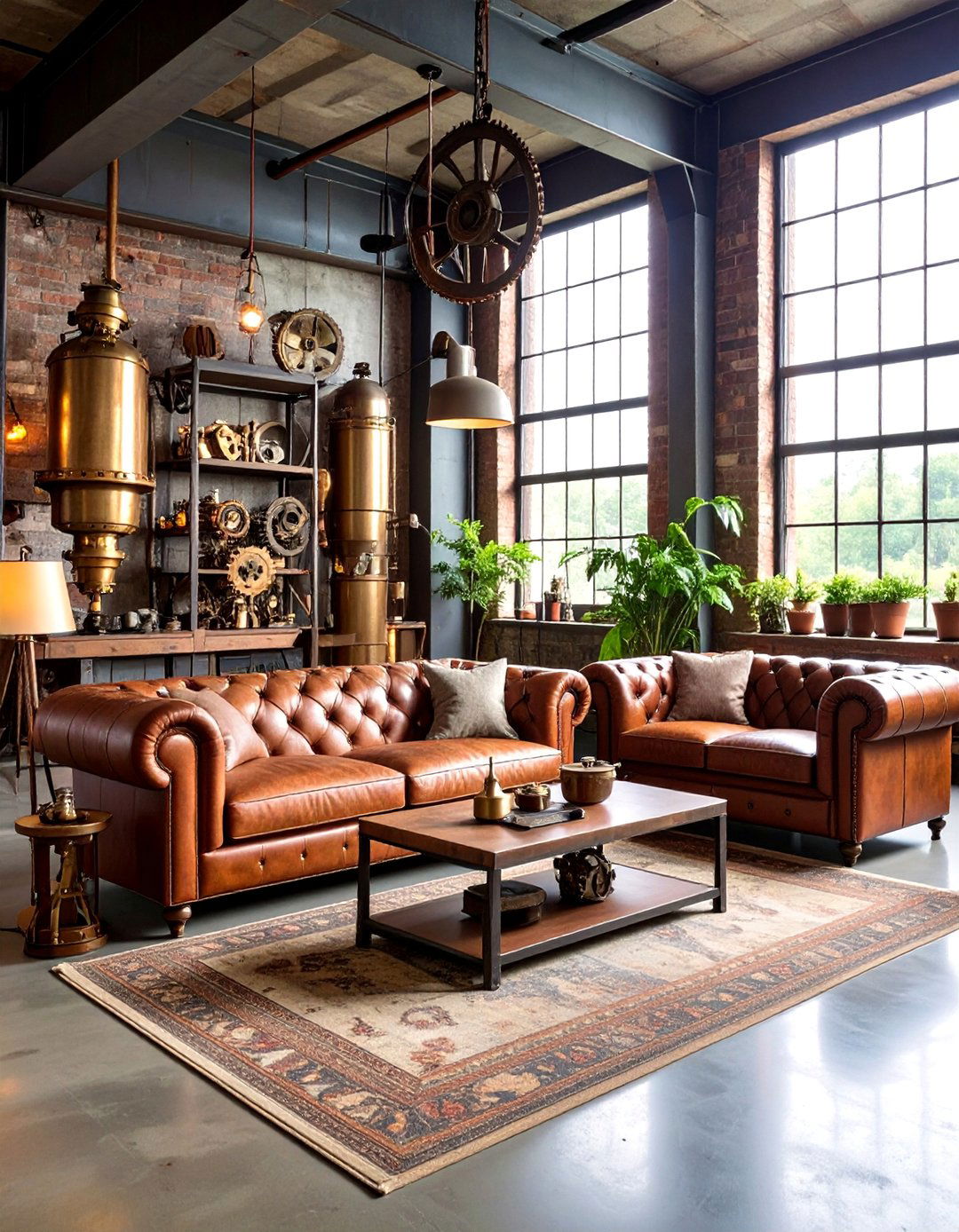



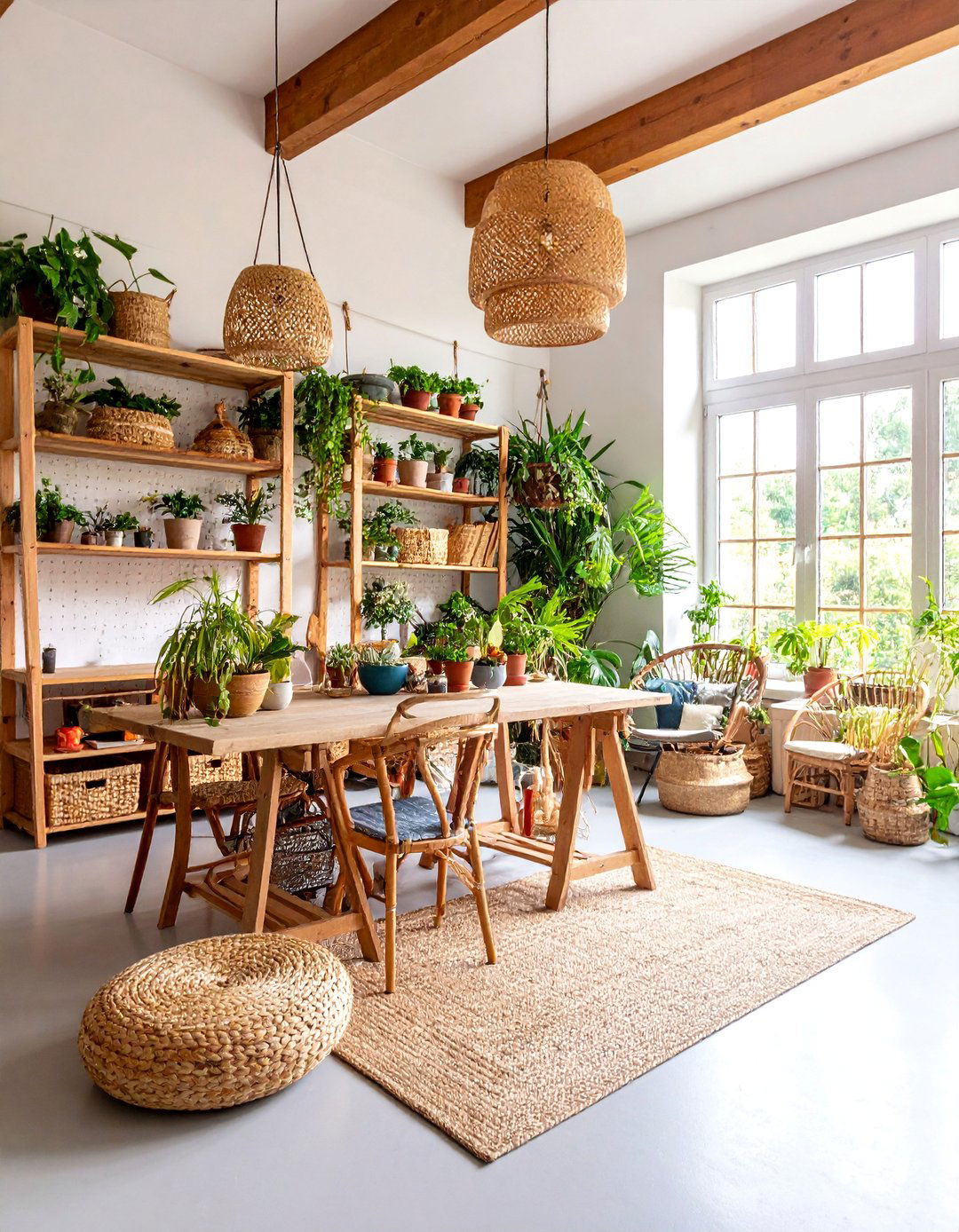


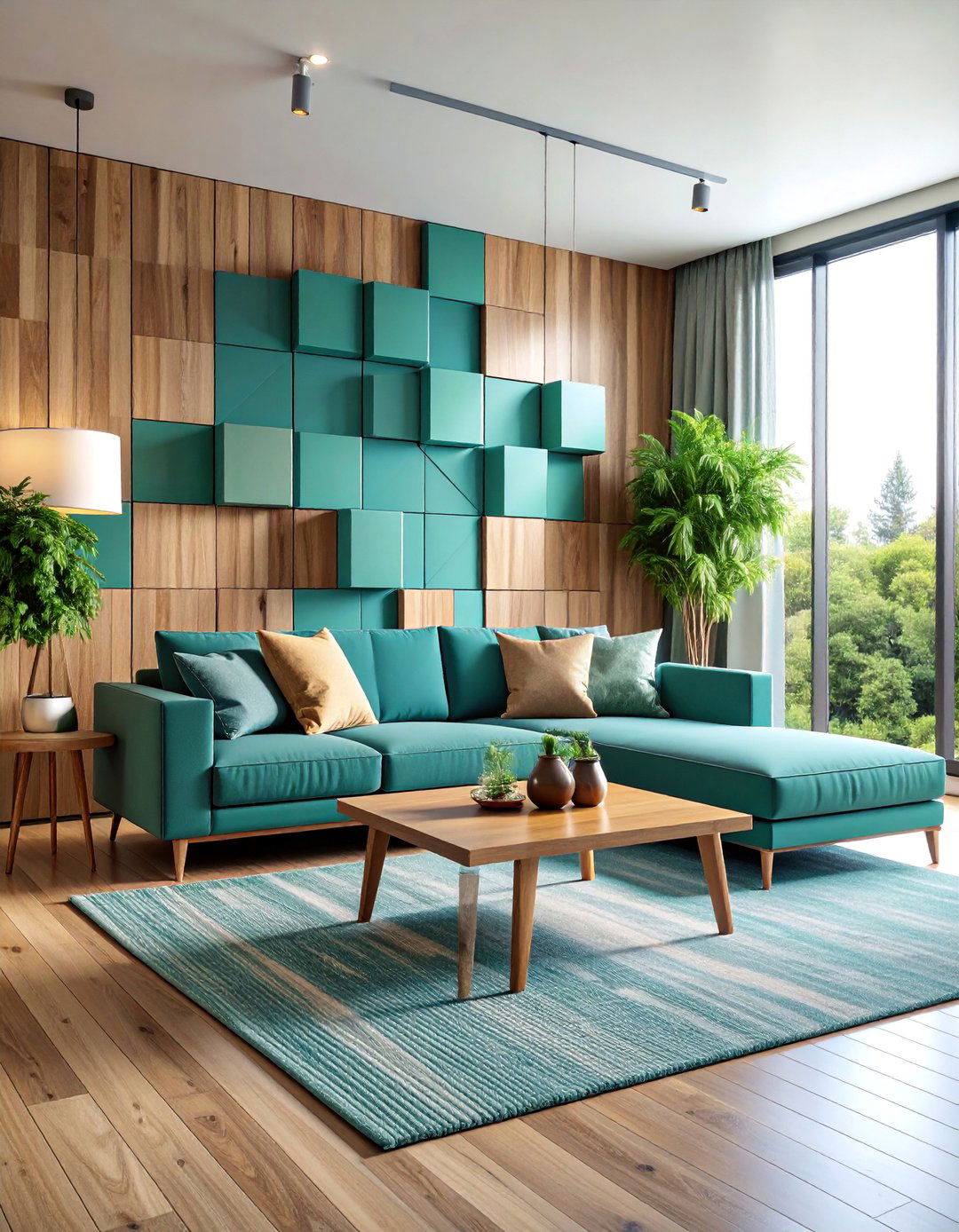

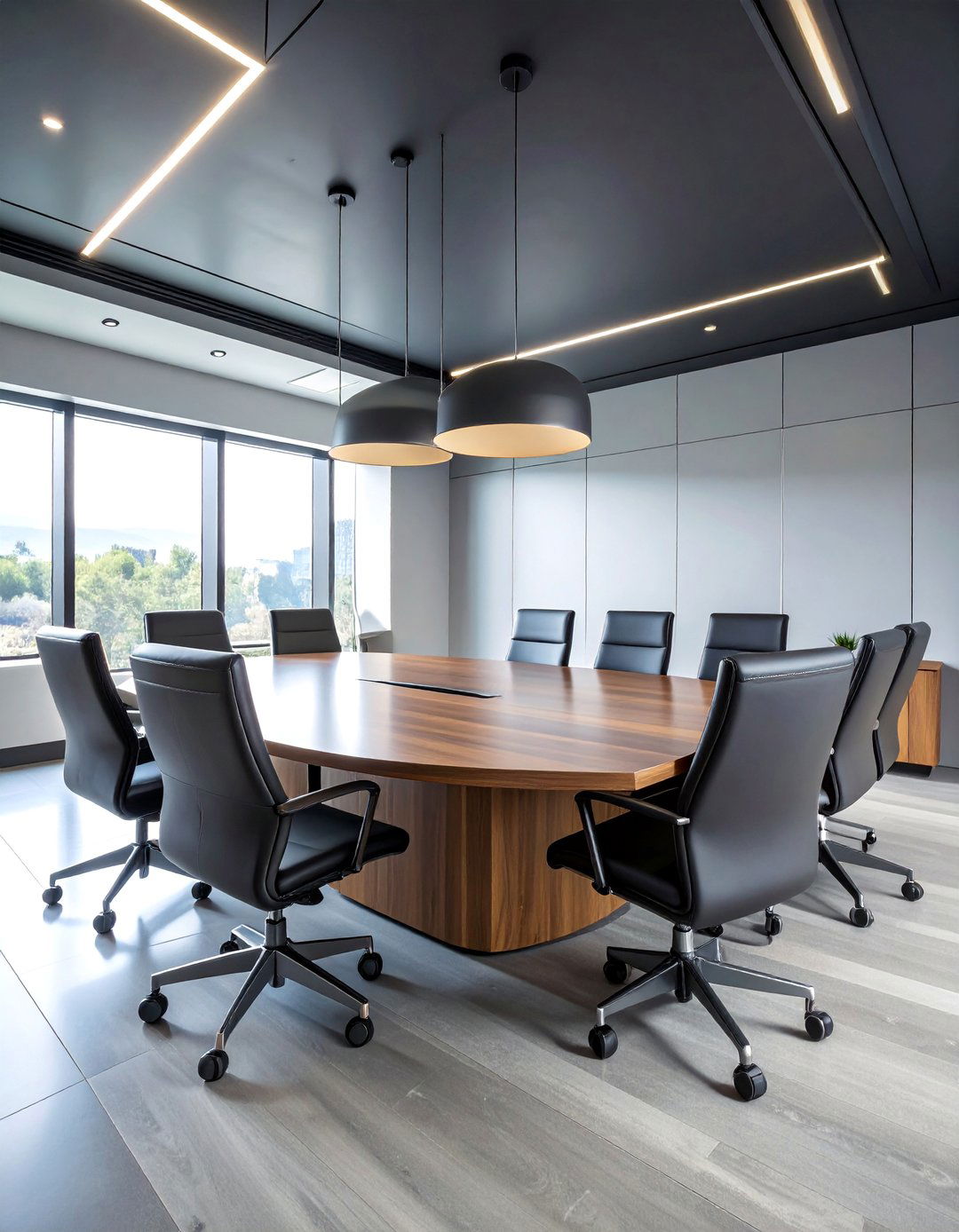


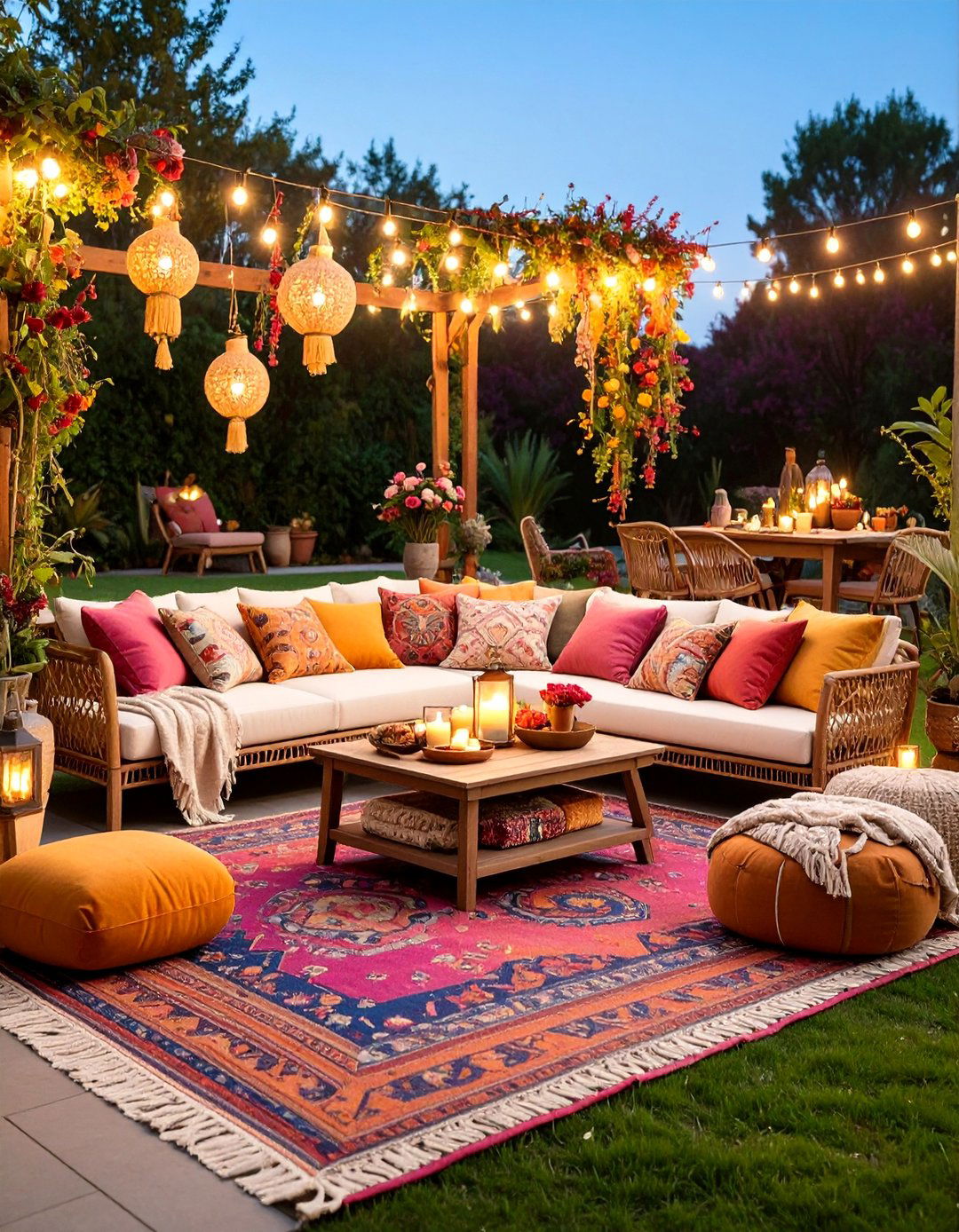
Leave a Reply